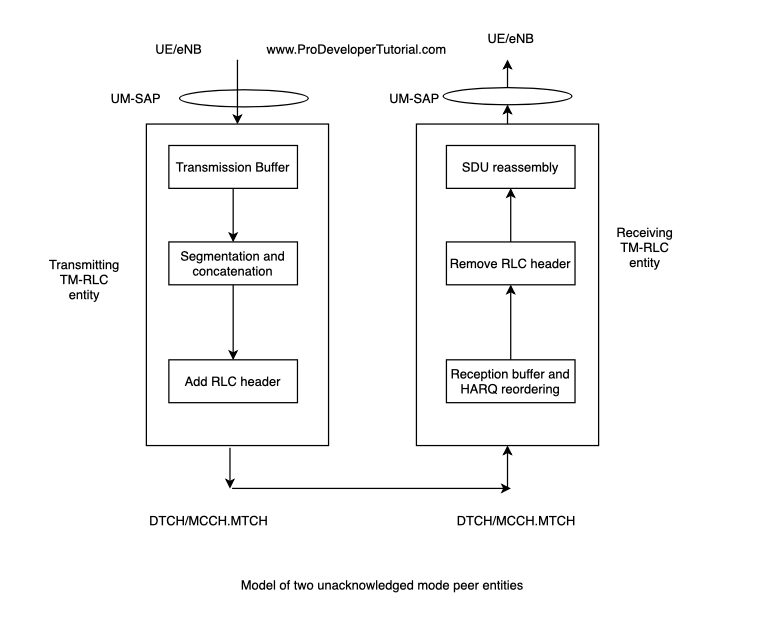RLC UM mode is used to deliver/receive the messages from DL/UL DTCH, MCCH and MTCH.
Here segmentation and reassembly of RLC SDUs will be performed.
RLC Headers are added/removed.
It will not guarantee delivery.
Functions performed by RLC UM Transmitting Entity
1. It will receive SDU from either PDCP or RRC.
2. It will add the SDU in transmission buffer.
3. It will segment or concatenate the RLC SDU to that UMD PDU fit within the total size of RLC PDU(s) indicated by lower layer
4. It will add RLC header to RLC PDU
5. It will pass RLC PDU to MAC for transmission.
Functions performed by RLC UM Receiving Entity
1. It will receive RLC PDU from MAC layer.
2. It will add the RLC PDU in reception buffer.
3. It will remove RLC header to RLC PDU
4. It will check for duplicate UMD PDU and discard the duplicate PDU.
5. It will reorder UMD PDU.
6. It will reassemble RLC SDU from the reordered UMD PDU.
7. It will pass assembled SDU to PDCP or RRC layer.
8. Any UMD PDU that cannot be re-assembled will be discarded.
UM Mode State Variables in RLC UM mode
1. VT(US) : UnAcknowledge Send State variable
It will hold the value of SN (Sequence Number) to be assigned to the next UMD PDU. Will be incremented once PDU is delivered to MAC
2. VT(UR) : UnAcknowledge Receive State Variable
It will hold SN of the earliest UMD PDU that is still considered for reordering
Initially it will be set to 0.
3. VT(UX) : UM t-reordering variable
It will hold the value of SN+1 for which t-reordering timer is triggered.
4. VT(UH) : UM Highest Received state variable
It will hold the value of highest SN for which Rx UM received among PDUs.
It will serve as top end of receive window.
RLC-UM Transmit Procedure
1. When delivering a new PDU to lower layers, the transmitting UM RLC will assign the SN in RLC header from VT(US) and increment the VT(US) by 1.
RLC-UM Receiving Procedure
1. The receiving UM RLC entity shall maintain reordering window VR(UH)
2. When an UMD PDU is received it will check if SN is outside re-ordering window or if the same SN is received, then it will discard the UMD PDU.
3. If UMD PDU is kept in reception buffer if it is within the reordering window, update the UM state variable and set/reset the t-reordering timer, reassemble the RLC SDU and send it to upper layer.
Reference TS 36.322
